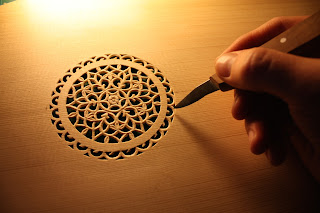April 2012
The bars in a lute are shaped, sized and placed according to magical rules that go somewhat beyond my understanding. I would be quite interested in learning how much the bracing affects the sound and how the optimal shape has been devised by the ancient makers. And I should re-read Lundberg.
For now, I'm just following the plan. I got some very nice quarter-sawn spruce from the local DIY shop with tight rings. The bars are cut and shaped as indicated. Simple.
Now the glueing. Luckily in april the apartment was still at a very low humidity level, around 34%, and not likely to dive much beyond that point, relieving me from the necessity to organise a heating system to bring it down even more artificially.
But then I had to build a go-bar box. I thought a second table, stacked on top of the other would easily do the trick, so I wouldn't have to bother building said box, not to mention storing it somewhere for later use.
I didn't do a proper full size dry run, I would have learned that all bars, under tension, can easily lift the table while standing on top of the bars, themselves standing on their narrow side! Anyway I managed to throw a couple of spanset around both tables to get things tight and get myself back to non-sweating.
A day or two after, with the glue dry, the bars are trimmed and planed, according to plan.
Once the bars are trimmed, the "box" can finally be closed! (Just for fit check). It starts to look like an instrument. One can see the slight gap between the shell and the soundboard, that will produce, once glued, the concave arching of the latter.































































